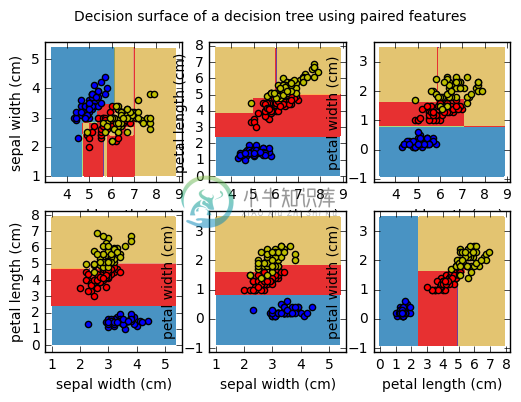决策树 Decision_trees - Ex 3: Plot the decision surface of a decision tree on the iris dataset
优质
小牛编辑
143浏览
2023-12-01
决策树/范例三: Plot the decision surface of a decision tree on the iris dataset
http://scikit-learn.org/stable/auto_examples/tree/plot_iris.html
此范例利用决策树分类器将资料集进行分类,找出各类别的分类边界。以鸢尾花资料集当作范例,每次取两个特征做训练,个别绘制不同品种的鸢尾花特征的分布范围。对于每对的鸢尾花特征,决策树学习推断出简单的分类规则,构成决策边界。
范例目的:
- 资料集:iris 鸢尾花资料集
- 特征:鸢尾花特征
- 预测目标:是哪一种鸢尾花
- 机器学习方法:decision tree 决策树
(一)引入函式库及内建测试资料库
from sklearn.datasets import load_iris将鸢尾花资料库存入,iris为一个dict型别资料。- 每笔资料中有4个特征,一次取2个特征,共有6种排列方式。
- X (特征资料) 以及 y (目标资料)。
DecisionTreeClassifier建立决策树分类器。
import numpy as npimport matplotlib.pyplot as pltfrom sklearn.datasets import load_irisfrom sklearn.tree import DecisionTreeClassifieriris = load_iris()for pairidx, pair in enumerate([[0, 1], [0, 2], [0, 3],[1, 2], [1, 3], [2, 3]]):X = iris.data[:, pair]y = iris.target
(二)建立Decision Tree分类器
建立模型及分类器训练
DecisionTreeClassifier():决策树分类器。fit(特征资料, 目标资料):利用特征资料及目标资料对分类器进行训练。
clf = DecisionTreeClassifier().fit(X, y)
(三)绘制决策边界及训练点
np.meshgrid:利用特征之最大最小值,建立预测用网格 xx, yyclf.predict:预估分类结果。plt.contourf:绘制决策边界。plt.scatter(X,y):将X、y以点的方式绘制于平面上,c为数据点的颜色,label为图例。
plt.subplot(2, 3, pairidx + 1)x_min, x_max = X[:, 0].min() - 1, X[:, 0].max() + 1y_min, y_max = X[:, 1].min() - 1, X[:, 1].max() + 1xx, yy = np.meshgrid(np.arange(x_min, x_max, plot_step),np.arange(y_min, y_max, plot_step))Z = clf.predict(np.c_[xx.ravel(), yy.ravel()]) #np.c_ 串接两个list,np.ravel将矩阵变为一维Z = Z.reshape(xx.shape)cs = plt.contourf(xx, yy, Z, cmap=plt.cm.Paired)plt.xlabel(iris.feature_names[pair[0]])plt.ylabel(iris.feature_names[pair[1]])plt.axis("tight")for i, color in zip(range(n_classes), plot_colors):idx = np.where(y == i)plt.scatter(X[idx, 0], X[idx, 1], c=color, label=iris.target_names[i],cmap=plt.cm.Paired)plt.axis("tight")

(四)完整程式码
print(__doc__)import numpy as npimport matplotlib.pyplot as pltfrom sklearn.datasets import load_irisfrom sklearn.tree import DecisionTreeClassifier# Parametersn_classes = 3plot_colors = "bry"plot_step = 0.02# Load datairis = load_iris()for pairidx, pair in enumerate([[0, 1], [0, 2], [0, 3],[1, 2], [1, 3], [2, 3]]):# We only take the two corresponding featuresX = iris.data[:, pair]y = iris.target# Trainclf = DecisionTreeClassifier().fit(X, y)# Plot the decision boundaryplt.subplot(2, 3, pairidx + 1)x_min, x_max = X[:, 0].min() - 1, X[:, 0].max() + 1y_min, y_max = X[:, 1].min() - 1, X[:, 1].max() + 1xx, yy = np.meshgrid(np.arange(x_min, x_max, plot_step),np.arange(y_min, y_max, plot_step))Z = clf.predict(np.c_[xx.ravel(), yy.ravel()]) #np.c_ 串接两个list,np.ravel将矩阵变为一维Z = Z.reshape(xx.shape)cs = plt.contourf(xx, yy, Z, cmap=plt.cm.Paired)plt.xlabel(iris.feature_names[pair[0]])plt.ylabel(iris.feature_names[pair[1]])plt.axis("tight")# Plot the training pointsfor i, color in zip(range(n_classes), plot_colors):idx = np.where(y == i)plt.scatter(X[idx, 0], X[idx, 1], c=color, label=iris.target_names[i],cmap=plt.cm.Paired)plt.axis("tight")plt.suptitle("Decision surface of a decision tree using paired features")plt.legend()plt.show()

